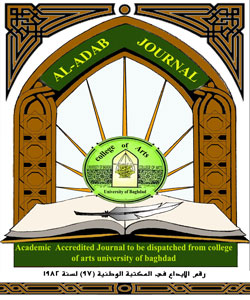عمارة المباني التراثية في النجف ودورها في تعزيز الهوية الوطنية
DOI:
https://doi.org/10.31973/aj.v0i129.586الكلمات المفتاحية:
التراث، الثقافة، التقاليد، الميراث، النجف، البيوت، التخطيطالملخص
يمثل التراث الذاكرة الحية للفرد والمجتمع ، وهو الهوية الثقافية التي يتعرف بها الناس على خصوصية شعب ما ، أي أنه السجل الكامل للنشاط الإنساني في مجتمع ما ، وهو مظهراً من مظاهر الإبداع الفردي والجماعي للأمة خلال تاريخها الطويل ، أما الهوية الوطنية فتمثل شرطاً وماخاً في التراث الثقافي ، فهي سند الإبداع وشرط الإحساس بالذات والانتماء ، إنها ترتكز على شعور غريزي بالانتماء والمحلية ، وتظهر ملازمة للثقافة الخاصة في حدود ملامحها الأصلية التي تشكل حاملا للهوية الوطنية .
إن الحديث عن التراث العماري في مدينة النجف ، الذي يعد أحد الركائز الاساسية لتراث المدينة عبر العصور ، يعني الحديث عن المتغيرات في الزمان المتحرك ، والمكان الثابت . والنجف في خططها وعمارتها كواحدة من المدن التاريخية ذات النشأة الدينية كان عليها أن تستجيب في تخطيطها العماري إلى مجموعة من الحاجات والعوامل التي اثرت في نمط التخطيط وشكل المدينة وطرز عمارة المباني فيها .
ولغرض التعمق في الموضوع تم اختيارنا للبيت النجفي القديم كنموذج للعمارة المحلية ، وتم اختيار بيت (السيد علي الدامرجي) الواقع في محلة الحويش كنموذج لها ، لما يمتاز به من التكامل في العناصر التخطيطية والعمارية والإنشائية ، فضلا عن سعة مساحتها البالغة (380 م2) وحالته الجيدة ، إذ صنفته لجنة المسح التراثي لمدينة النجف بدرجة (أ) من حيث الحالة التراثية وحالة البناء .
توصلت الدراسة إلى أن عمارة المباني التراثية في النجف والبيت النجفي منها على وجه الخصوص ، امتازت ببعض الخصائص التي تكاد أن تكون منفردة بها ، إلا أن هذه الخصوصية لا تعني الانفراد بهوية مستقلة ، بل هي الخصوصية المحلية التي تتكامل في صورتها الكلية ضمن الهوية الوطنية للتراث العراقي ، فعلى الرغم من وجود تأثيرات مشرقية مختلفة ، فان البيت النجفي ظل محافظاً في تخطيطه الأساسي على طابعه التقليدي ، الذي يحاكي الطراز الحيري والعراقي القديم ، وهذا بحد ذاته يرسم صورة للتواصل الحضاري العراقي واصالته عبر العصور .
التنزيلات
المراجع
Al-Ansari, Rauf Mohammad Ali, "Najaf Al-Ashraf: A Long-Term Islamic City, A Study of Its Most Urban Features", Research in Najaf Al-Ashraf Contributions to Human Civilization, C2 London: Islamic Center, 2000, pp. 456-457.
al-Asadi, Hasan, Najaf Revolution, Baghdad: Alhruaa Printing Press,1975, P. 17.
al-Hakim, Hassan Issa, "Planning the Islamic city of Najaf and Kufa model" Journal of Studies Najaf, No. 5, 2006, p.26.
Alian, Jamal, Conservation of Cultural Heritage, World Knowledge Series, Book 322, Kuwait, p.60.
Al-Mallah, Hashim Yahya, The Concept of Heritage in Arab Thought and its Problems, Baghdad, 2000, Iraqi Academy of Sciences, p.5.
Al-Qusairi, Aatmad Yusuf, The Planning and Architectural Characteristics of the House of Baghdadi during the Ottoman Period, Beirut, 2012, Dar Al-Witb Foundation), p.5.
Al-Sharqi, Talib Ali, Najaf Al-Ashraf customs and traditions, Najaf: Press Arts, 1978, p.39.
Auji, Firas Yellouz Abdelkader, Criminal Protection of Archeology, Unpublished MA thesis submitted to the Faculty of Law, University of Baghdad, 1998, p.10.
For the diaries of the siege and the movement of the revolutionaries within these channels, see the memoirs of Shabibi published in the new culture magazine, No. 4, July 1969, pp. 285- 340.
Makiya, Mohammed, "What I hope from the urban planning of the city of Najaf," Najaf Al-Ashraf contributions to human civilization, C2, London, 2000, p. 464.
Najaf Mayor Shaker Hamid said that in these corridors held meetings, and political conferences, and is the only way to establish councils of people and forbidden in Najaf. M.I. The Secret Report No. 28 of 12 February 1934, "Reports of the Administrative Role / Karbala Brigade", numbered 59 / K-2, p.
Najaf was invaded by the Wahhabis for the first time in 1802 and their threats were repeated until 1922. For more information, see: al-Basri, Othman bin Sanad, Mutawal al-Saud, Mosul, Dar al-Hikma, 1991.
See Al-Muzaffar, Mohsen Abdul-Saheb, Najaf City, pp. 177-186.
Shalash, Abd al-Muhsin, Najaf wells and streams, Najaf: Al-Ra'ee Press, 1947, pp. 6-7.
Shalash, Abd al-Muhsin, Najaf wells and streams, Najaf: Al-Ra'ee Printing Press, 1947, pp. 4-7.
The General Authority for Antiquities and Heritage - Heritage Department, Najaf Governorate File, Heritage Role Form No. 35C, on 8November, 2011.
The number of ancient heritage houses still in existence in the ancient city of Najaf is 24 houses, 8 in locality of Mashraq, 2 in the Amarah, 8 in Al-Hawish, and 6 in Al-Buraq district. Hussein, Hamza Abbas, Heritage Buildings in Najaf, Baghdad, 2017, the stream of publications,p.122.
The number of houses according to the official census of 1934 is (5219) houses, the number of basements is not less than this number a lot, since it is rare to have a house of crypt or more.
Tizini, Tayeb, The World Heritage Concept Introduction to Foundations, World of Thought Magazine, Issue 4, April 2008, p.60.
UNESCO = United Nations Educational , Scientific and Cultural Organization Convention for the Protection of the World Cultural and Natural Heritage, Paris, 1972, article 1, p. 4. http://whc.unesco.org/archive/convention.
Yusuf, Sharif, History of Iraqi Architecture in Various Ages, Baghdad, Dar Al Rasheed Publishing, p. 582.
التنزيلات
منشور
إصدار
القسم
الرخصة
:حقوق الطبع والنشر والترخيص
بالنسبة لجميع البحوث المنشورة في مجلة الآداب، يحتفظ الباحثون بحقوق النشر. يتم ترخيص البحوث بموجب ترخيص Creative Commons CC BY 4.0 المفتوح ، مما يعني أنه يجوز لأي شخص تنزيل البحث وقراءته مجانًا. بالإضافة إلى ذلك ، يجوز إعادة استخدام البحث واقتباسه شريطة أن يتم الاستشهاد المصدر المنشور الأصلي. تتيح هذه الشروط الاستخدام الأقصى لعمل الباحث وعرضه.
:إعادة إنتاج البحوث المنشورة من الناشرين الآخرين
من الضروري للغاية أن يحصل الباحثون على إذن لإعادة إنتاج أي بحث منشورة (أشكال أو مخططات أو جداول أو أي مقتطفات من نص) لا يدخل في نطاق الملكية العامة أو لا يملكون حقوق نشرها. يجب أن يطلب الباحثون إذنًا من مؤلف حقوق النشر (عادة ما يكون الناشر).
يطلب الإذن في الحالات التالية:
بحوثك الخاصة المنشورة من قِبل ناشرين آخرين ولم تحتفظ بحقوق النشر الخاصة بها.
مقتطفات كبيرة من بحوث أي شخص أو سلسلة من البحوث المنشورة.
استخدم الجداول والرسوم البيانية والمخططات والمخططات والأعمال الفنية إذا لم يتم التعديل عليها.
الصور الفوتوغرافية التي لا تملك حقوق لنشرها.
لا يطلب الإذن في الحالات التالية:
إعادة بناء الجدول الخاص بك مع البيانات المنشورة بالفعل في مكان آخر. يرجى ملاحظة أنه في هذه الحالة يجب عليك ذكر مصدر البيانات في شكل "بيانات من ..." أو "مقتبس من ...".
تعتبر عروض الأسعار القصيرة معقولة الاستخدام العادل ، وبالتالي لا تتطلب إذنًا.
الرسوم البيانية ، الرسوم البيانية ، المخططات ، الأعمال الفنية التي أعاد الباحث رسمها بالكامل والتي تم تغييرها بشكل ملحوظ إلى درجة لا تتطلب الاعتراف.
الحصول على إذن
لتجنب التأخير غير الضروري في عملية النشر ، يجب أن تبدأ في الحصول على أذونات في أقرب وقت ممكن. لا يمكن لمجلة الآداب نشر بحث مقتبس من منشورات أخرى دون إذن.
قد يمنحك مالك حقوق الطبع والنشر تعليمات بشأن شكل الإقرار الواجب اتباعه لتوثيق عمله ؛ بخلاف ذلك ، اتبع النمط: "مستنسخ بإذن من [المؤلف] ، [كتاب / المجلة] ؛ نشره [الناشر] ، [السنة]." في نهاية شرح الجدول ، الشكل أو المخطط.
.jpg)























